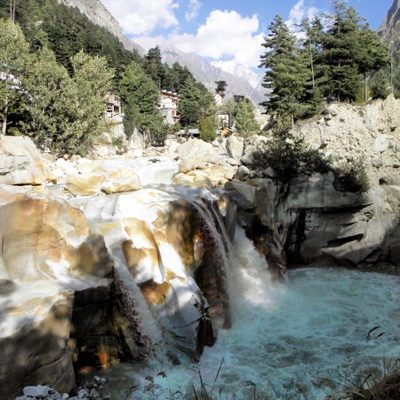Complete Guide about Gangotri
-
Location
Gangotri Temple, XWVR+QG5, Gangotri, Uttarakhand 249135
-
Best Time to Visit
April, May, June, September, October, November
-
Entry Fee
No fee is required.


The architecture of Gangotri Temple is probably in the Nagara style. It is built simply from white marble stone. There aren’t any inside carvings like those sometimes seen in Hindu temples. There are five little 20-foot-tall apexes (shikhars). The Garba Griha, the primary sanctuary, is constructed on a high platform. In front of the Garba Griha, there is a mandap where worshippers offer prayers and worship. The idol of Goddess Ganga is located in the inner sanctum. The goddesses Yamuna, Annapurna, Saraswati, and Lakshmi’s idols are also present. The collection of idols situated inside the inner sanctorum is completed by the statues of Bhagirath and the sage Adi Sankara. Lord Ganesha, Hanuman, Bhagirathi, and Lord Shiva each have their own tiny temple.
- Registration of your vehicle(s) is required.
- The driver should keep a list of all the passengers sitting in the vehicle.
- Give way to vehicles going uphill on mountain roads first.
- The driver should keep all the valid documents of the vehicle, keep an extra stepney.
- Before travelling, you must get the green card from the transport office.
- Be sure to honk on the turns in the mountain roads.
- While parking the vehicle, usage of the hand brake is a must. Parking should be done at the designated place only.
- Carry proof or scanned QR code with you.
- Do not drive on mountain roads before 4 am and after 10 pm.
- Do not overtake on the road turns.
- Do not drink and drive.
- Do not travel sitting on the top of the vehicle.
- Do not litter dirty clothes and polybags.
- Do not use private vehicles for commercial purposes.
- Following a comprehensive health examination, the pilgrims should start their Yatra.
- People with pre-existing conditions should carry enough prescription medication, as well as their doctors’ contact information and prescriptions.
- Senior citizens, persons with comorbid conditions, and people who have already experienced COVID 19 should think about delaying or opting out of the journey.
- Before arriving at the ultimate pilgrimage location, there should be at least one day of rest planned in the journey itinerary.
- Please make sure you have plenty of warm, woollen clothing with you.
- Patients suffering from Heart Diseases, Respiratory ailments, Diabetes, and Hypertension should be extra cautious while undertaking travel to high altitudes.
- If you have symptoms such as a headache, dizziness, drowsiness, tightness in the chest, nausea, vomiting, coughing, rapid breathing, or an elevated heart rate, you should see a doctor right once or call the 104 or 108 helplines for support.
- Avoid using alcohol and other drugs, and don’t smoke.
- SPF 50 sunscreen can be used to protect skin from the sun’s rays.
- Additionally, sunglasses can shield the eyes from UV rays.
- Maintain a healthy level of hydration, and avoid travelling on an empty stomach.
- While trekking or walking, take frequent breaks.
- High altitude activity should not be hard.
- In case of emergencies, Helpline numbers [108 – National Ambulance
- You can reach service and 104- Uttarakhand Health Helpline.
Get Direction to Gangotri
Near Attractions











